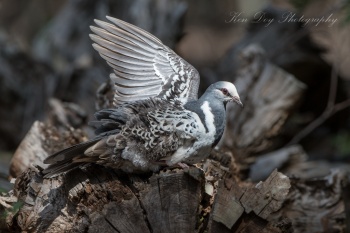- Leucosarcia melanoleuca
Leucosarcia picata
Identification
38–45 cm (15-17¾ in)
- Pale blue-grey back
- Creamy-white head
- White underparts dotted with dark grey spots
- Short neck
- Broad wings
- Long tail
- Dark reddish-brown eyes with pink eye-rings
- Red legs
Sexes similar. Juveniles are browner with a less distinct V pattern on chest.
Distribution
Australia: found in coastal forests of eastern Australia (central Queensland to south-eastern Victoria)
Taxonomy
This is a monotypic species[1].
Habitat
Dense temperate rainforests, wet eucalypt forests, coastal forests, picnic areas, walking tracks, carparks and gardens.
Behaviour
Diet
The diet consists of fruit, berries, seeds from native forest trees.
Breeding
They construct a twig platform nest, about 3 to 20 m above the ground. Sometimes they will use abandoned nests from Topknot Pigeons or Tawny Frogmouths. The clutch contains 2 large eggs. Both adults incubate the eggs and feed the young.
References
- Clements, J. F., T. S. Schulenberg, M. J. Iliff, D. Roberson, T. A. Fredericks, B. L. Sullivan, and C. L. Wood. 2018. The eBird/Clements checklist of birds of the world: v2018. Downloaded from http://www.birds.cornell.edu/clementschecklist/download/
- Handbook of the Birds of the World Alive (retrieved Sept 2018)
Recommended Citation
- BirdForum Opus contributors. (2024) Wonga Pigeon. In: BirdForum, the forum for wild birds and birding. Retrieved 14 May 2024 from https://www.birdforum.net/opus/Wonga_Pigeon
External Links





